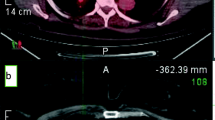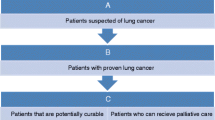Abstract
Purpose
To assess diagnostic accuracy of 18F-FDG PET/CT at 3 months for the detection of local recurrence after radiofrequency ablation (RFA) of lung metastases.
Methods
The PET/CT scan at 3 months was compared with a baseline PET/CT scan from a maximum of 2 months before RFA, with the reference standard as recurrence diagnosed by CT during a 12-month follow-up. Local recurrence was diagnosed on the PET/CT scan if lesional uptake was greater than the mediastinal background. Maximum standardized uptake values (SUVmax) were recorded. ROC curve analysis for SUVmax was performed. Overall survival (OS) and time to local relapse were computed from the date of RFA using the Kaplan-Meier method (www.clinicaltrials.gov: NCT 00382252).
Results
Between 2005 and 2009, 89 patients (mean age 65 years) underwent RFA for 115 lung metastases (mean size 16.2 ± 6.9 mm). The median SUVmax before RFA was 5.8 ± 4. PET/CT at 3 months and the reference standard were available in 77 patients and 100 lesions. Accuracy was 66.00 % (95 % CI 55.85–75.18 %), sensitivity 90.91 % (95 % CI 58.72–99.77 %), specificity 62.92 % (95 % CI 52.03–72.93 %), PPV 23.26 % (95 % CI 11.76–38.63 %), and NPV 98.25 % (95 % CI 90.61–99.96 %). One-year OS was 94.2 % (95 % CI 86.6–97.5 %) and the probability of being free of local recurrence 1 year after RFA was 84.6 % (95 % CI 75.0–90.8 %).
Conclusion
The specificity of PET/CT at 3 months is low because of persistent inflammation, especially when the lesion is close to the pleura. This technique is useful for its negative predictive value, but positive findings need to be confirmed by histology before new treatment is planned.







Similar content being viewed by others
References
Ambrogi MC, Fanucchi O, Cioni R, Dini P, De LA, Cappelli C, et al. Long-term results of radiofrequency ablation treatment of stage I non-small cell lung cancer: a prospective intention-to-treat study. J Thorac Oncol. 2011;6(12):2044–51.
Facey K, Bradbury I, Laking G, Payne E. Overview of the clinical effectiveness of positron emission tomography imaging in selected cancers. Health Technol Assess. 2007;11(44):iii–iv, xi–267.
de Baère T, Palussière J, Aupérin A, Hakime A, Abdel-Rehim M, Kind M, et al. Midterm local efficacy and survival after radiofrequency ablation of lung tumors with minimum follow-up of 1 year: prospective evaluation. Radiology. 2006;240(2):587–96.
Simon CJ, Dupuy DE, DiPetrillo TA, Safran HP, Grieco CA, Ng T, et al. Pulmonary radiofrequency ablation: long-term safety and efficacy in 153 patients. Radiology. 2007;243(1):268–75.
Suh R, Reckamp K, Zeidler M, Cameron R. Radiofrequency ablation in lung cancer: promising results in safety and efficacy. Oncology (Williston Park). 2005;19(11 Suppl 4):12–21.
Yan TD, King J, Sjarif A, Glenn D, Steinke K, Morris DL. Percutaneous radiofrequency ablation of pulmonary metastases from colorectal carcinoma: prognostic determinants for survival. Ann Surg Oncol. 2006;13(11):1529–37.
Yan TD, King J, Sjarif A, Glenn D, Steinke K, Al-Kindy A, et al. Treatment failure after percutaneous radiofrequency ablation for nonsurgical candidates with pulmonary metastases from colorectal carcinoma. Ann Surg Oncol. 2007;14(5):1718–26.
Akeboshi M, Yamakado K, Nakatsuka A, Hataji O, Taguchi O, Takao M, et al. Percutaneous radiofrequency ablation of lung neoplasms: initial therapeutic response. J Vasc Interv Radiol. 2004;15(5):463–70.
Palussière J, Marcet B, Descat E, Deschamps F, Rao P, Ravaud A, et al. Lung tumors treated with percutaneous radiofrequency ablation: computed tomography imaging follow-up. Cardiovasc Intervent Radiol. 2011;34(5):989–97.
Therasse P, Arbuck SG, Eisenhauer EA, Wanders J, Kaplan RS, Rubinstein L, et al. New guidelines to evaluate the response to treatment in solid tumors. European Organization for Research and Treatment of Cancer, National Cancer Institute of the United States, National Cancer Institute of Canada. J Natl Cancer Inst. 2000;92(3):205–16.
Travaini LL, Trifiro G, Ravasi L, Monfardini L, Della VP, Bonomo G, et al. Role of [18F]FDG-PET/CT after radiofrequency ablation of liver metastases: preliminary results. Eur J Nucl Med Mol Imaging. 2008;35:1316–22.
Deandreis D, Leboulleux S, Dromain C, Auperin A, Coulot J, Lumbroso J, et al. Role of FDG PET/CT and chest CT in the follow-up of lung lesions treated with radiofrequency ablation. Radiology. 2011;258(1):270–6.
Singnurkar A, Solomon SB, Gonen M, Larson SM, Schoder H. 18F-FDG PET/CT for the prediction and detection of local recurrence after radiofrequency ablation of malignant lung lesions. J Nucl Med. 2010;51(12):1833–40.
Yoo DC, Dupuy DE, Hillman SL, Fernando HC, Rilling WS, Shepard JA, et al. Radiofrequency ablation of medically inoperable stage in non-small cell lung cancer: are early posttreatment PET findings predictive of treatment outcome? AJR Am J Roentgenol. 2011;197(2):334–40.
Bossuyt PM, Reitsma JB, Bruns DE, Gatsonis CA, Glasziou PP, Irwig LM, et al. Towards complete and accurate reporting of studies of diagnostic accuracy: the STARD initiative. AJR Am J Roentgenol. 2003;181(1):51–5.
Chua TC, Sarkar A, Saxena A, Glenn D, Zhao J, Morris DL. Long-term outcome of image-guided percutaneous radiofrequency ablation of lung metastases: an open-labeled prospective trial of 148 patients. Ann Oncol. 2010;21:2017–22.
Yamakado K, Hase S, Matsuoka T, Tanigawa N, Nakatsuka A, Takaki H, et al. Radiofrequency ablation for the treatment of unresectable lung metastases in patients with colorectal cancer: a multicenter study in Japan. J Vasc Interv Radiol. 2007;18(3):393–8.
Antoch G, Vogt FM, Veit P, Freudenberg LS, Blechschmid N, Dirsch O, et al. Assessment of liver tissue after radiofrequency ablation: findings with different imaging procedures. J Nucl Med. 2005;46(3):520–5.
Barker DW, Zagoria RJ, Morton KA, Kavanagh PV, Shen P. Evaluation of liver metastases after radiofrequency ablation: utility of 18F-FDG PET and PET/CT. AJR Am J Roentgenol. 2005;184(4):1096–102.
Dierckx R, Maes A, Peeters M, Van de Wiele C. FDG PET for monitoring response to local and locoregional therapy in HCC and liver metastases. Q J Nucl Med Mol Imaging. 2009;53(3):336–42.
Kele PG, de Jong KP, van der Jagt EJ. Increase in volume of ablation zones during follow-up is highly suggestive of ablation site recurrence in colorectal liver metastases treated with radiofrequency ablation. J Vasc Interv Radiol. 2012;23(4):537–44.
Kuehl H, Antoch G, Stergar H, Veit-Haibach P, Rosenbaum-Krumme S, Vogt F, et al. Comparison of FDG-PET, PET/CT and MRI for follow-up of colorectal liver metastases treated with radiofrequency ablation: initial results. Eur J Radiol. 2008;67(2):362–71.
Langenhoff BS, Oyen WJ, Jager GJ, Strijk SP, Wobbes T, Corstens FH, et al. Efficacy of fluorine-18-deoxyglucose positron emission tomography in detecting tumor recurrence after local ablative therapy for liver metastases: a prospective study. J Clin Oncol. 2002;20(22):4453–8.
Sahin DA, Agcaoglu O, Chretien C, Siperstein A, Berber E. The utility of PET/CT in the management of patients with colorectal liver metastases undergoing laparascopic radiofrequency thermal ablation. Ann Surg Oncol. 2012;19(3):850–5.
Veit P, Kuhle C, Beyer T, Kuehl H, Herborn CU, Borsch G, et al. Whole body positron emission tomography/computed tomography (PET/CT) tumour staging with integrated PET/CT colonography: technical feasibility and first experiences in patients with colorectal cancer. Gut. 2006;55(1):68–73.
Sharma A, Lanuti M, He W, Palmer EL, Shepard JA, Digumarthy SR. Increase in fluorodeoxyglucose positron emission tomography activity following complete radiofrequency ablation of lung tumors. J Comput Assist Tomogr. 2013;37(1):9–14.
Boellaard R. Standards for PET image acquisition and quantitative data analysis. J Nucl Med 2009;50 Suppl 1:11S–20S.
Fletcher JW, Djulbegovic B, Soares HP, Siegel BA, Lowe VJ, Lyman GH, et al. Recommendations on the use of 18F-FDG PET in oncology. J Nucl Med. 2008;49(3):480–508.
Purandare NC, Rangarajan V, Shah SA, Sharma AR, Kulkarni SS, Kulkarni AV, et al. Therapeutic response to radiofrequency ablation of neoplastic lesions: FDG PET/CT findings. Radiographics. 2011;31(1):201–13.
Okuma T, Matsuoka T, Okamura T, Wada Y, Yamamoto A, Oyama Y, et al. 18F-FDG small-animal PET for monitoring the therapeutic effect of CT-guided radiofrequency ablation on implanted VX2 lung tumors in rabbits. J Nucl Med. 2006;47(8):1351–8.
Itti E, Juweid ME, Haioun C, Yeddes I, Hamza-Maaloul F, El Bez I, et al. Improvement of early 18F-FDG PET interpretation in diffuse large B-cell lymphoma: importance of the reference background. J Nucl Med 2010;51(12):1857–62.
Lin C, Itti E, Haioun C, Petegnief Y, Luciani A, Dupuis J, et al. Early 18F-FDG PET for prediction of prognosis in patients with diffuse large B-cell lymphoma: SUV-based assessment versus visual analysis. J Nucl Med. 2007;48(10):1626–32.
Graham MM, Badawi RD, Wahl RL. Variations in PET/CT methodology for oncologic imaging at U.S. academic medical centers: an imaging response assessment team survey. J Nucl Med. 2011;52(2):311–7.
Delbeke D, Coleman RE, Guiberteau MJ, Brown ML, Royal HD, Siegel BA, et al. Procedure guideline for tumor imaging with 18F-FDG PET/CT 1.0. J Nucl Med. 2006;47(5):885–95.
Higaki F, Okumura Y, Sato S, Hiraki T, Gobara H, Mimura H, et al. Preliminary retrospective investigation of FDG-PET/CT timing in follow-up of ablated lung tumor. Ann Nucl Med. 2008;22(3):157–63.
Deandreis D, Al GA, Leboulleux S, Lacroix L, Garsi JP, Talbot M, et al. Do histological, immunohistochemical and metabolic (radioiodine and fluorodeoxyglucose uptake) patterns of metastatic thyroid cancer correlate with patient outcome? Endocr Relat Cancer. 2011;18:159–69.
Suzawa N, Yamakado K, Takao M, Taguchi O, Yamada T, Takeda K. Detection of local tumor progression by 18F-FDG PET/CT following lung radiofrequency ablation: PET versus CT. Clin Nucl Med. 2013;38(4):e166–70.
Acknowledgments
The authors would like to thank the French Ministry of Health for financial support, Béatrice Gonzales for data collection and control and Pippa McKelvie-Sebileau of Institut Bergonié for assistance with medical writing.
Disclosures
The authors have no disclosures to declare.
Funding source
This work was supported by a PHRC 2006 (Programme Hospitalier de Recherche Clinique) of the French Ministry of Health.
Prior presentations
This work was presented at the Society of Nuclear Medicine Annual Meeting, San Antonio, June 2011, and the Cardiovascular and Interventional Radiological Society of Europe Annual Meeting, Munich, September 2011.
Author information
Authors and Affiliations
Corresponding author
Additional information
The reference of the study according to the international clinical trials base CLINTRIAL (www.clinicaltrials.gov) is NCT 00382252.
Rights and permissions
About this article
Cite this article
Bonichon, F., Palussière, J., Godbert, Y. et al. Diagnostic accuracy of 18F-FDG PET/CT for assessing response to radiofrequency ablation treatment in lung metastases: a multicentre prospective study. Eur J Nucl Med Mol Imaging 40, 1817–1827 (2013). https://doi.org/10.1007/s00259-013-2521-9
Received:
Accepted:
Published:
Issue Date:
DOI: https://doi.org/10.1007/s00259-013-2521-9




